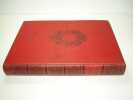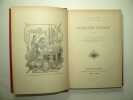FOE Daniel de, BRESSIER Henri
Robinson Crusoé
Petit in-folio (21,5x30,5cm) 336 pages, cartonnage de l'éditeur illustré en couleurs, reliure d'Engel. Tranches dorées. (1985g) Paris, Librairie Nationale d'Education et de Récréation, 1900
Reference : 11716
Illustré par Henri Bressler. Illustré de 33 gravures et grande lettre ornée au commencement de chaque chapitre. Ors légèrement passés par endroits. Pas de rousseurs. Bon exemplaire bien conservé. Très bon état. Réf 11716.
Bookseller's contact details
Marc Aubry
Marc Aubry
02 54 70 44 90
Payment mode
Sale conditions
Vous pouvez demander tout renseignement par mail ou téléphone. Les frais de port sont calculés au poids selon les tarifs postaux. Nous vous les communiquons dans le mail de confirmation de votre commande ou sur demande. Règlement par chèque, virement ou Paypal. Emballage soigné. <br /><br /><br />
5 book(s) with the same title
Aventures de Robinson Crusoé par Daniel de Foe, traduites par Mme Amable Tastu, précédé d une Notice sur de Foe, par M. Philarète Chasles, et suivies d une notice sur le matelot Selkirk, sur l île de Juan-Fernandez, sur les Caraïbes et les Puelches par F. Denis, et d une Dissertation religieuse par l abbé Labouderie. Nouvelle édition revue et corrigée.
Paris, Didier-libraire, 1845. Petit in-4 relié demi-chagrin, titre et ornements dorés sur le dos, toutes tranches dorées, XXVIII-476 pages, richement illustré de planches hors-texte et de vignettes dans le texte, têtes de chapitre, culs-de-lampe.-1,1kg.- Rousseurs claires inégalement. Reliure solide en bel état.
Vie et aventures de Robinson Crusoé.
Paris, chez H. Verdière, 1821. Nouvelle édition revue et corrigée.- 2 volumes in-8 reliés (21,5 x 13 cm), reliure demi-veau glacé vert-olive, titre doré sur pièce de cuir beige, filets, plats de papier marbré assorti, gardes postérieures de papier vert-d'eau, CI (100)- 430- 512 pages. Edition complète en deux volumes, ornée de 19 gravures et d'une carte dépliante, préface de l'éditeur pour cette édition, Vie de daniel Defoe, table des matières.- Portrait en frontispice, 1 carte dépliante (double mappemonde) et dix-huit gravures hors-texte de Delvaux d'après Stothart. - 1340g.C. - Intérieur très frais et exempt de rousseurs (rare), reliure solide et en très bon état
Vie et aventures de Robinson Crusoé et Voyages de Gulliver.
Sans mention d'éditeur, ni date (vers 1930). Album cartonné (32 x 23 cm), illustré au premier plat, dos toilé rouge, 68 pages, illustré de nombreux dessins en noir dans le texte et de deux planches en couleurs hors-texte.-450g.L. - Intérieur propre, couverture avec traces d'usage, bords un peu frottés. Etat correct.
Aventures de Robinson Crusoé.- illustrées par THIRIET & MYRBACH.
Librairies-Imprimeries Réunies L. Martinet. Collection Bibliothèque de la Jeunesse et de l'Enfance. Paris. Sans Date. Vers, 1934. In-4 relié (33 x 24,7 cm), premier plat illustré, filets dorés, médaillon et titre rouge, 72 pages, orné de 12 illustrations en noir & blanc à pleine page de Thiriet et 8 planches en couleurs hors texte de Myrbach.-650g.L. - Intérieur et cartonnage très frais, exempt de rousseurs. Très bel exemplaire.
Das Leben und die gantz ungemeine Begebenheiten des weltberuffenen Engellanders Robinson Crusoe, welcher durch Sturm und Schiffbruch (...).Die Zweyte Hamburgische Ausgabe. (+) Das Leben und die gantz ungemein merckwürdigen Begebenheiten Des Weltberühm... - [GERMAN ROBINSON CRUSOE AND RONBINSONADE]
Hamburg, Wierings Erben, 1721 (Part 1) Leipzig, Weidmann, 1721 (part 2) Leyden, Peter Robinson, 1721 (part III & IV). 8vo. Four parts uniformly bound in two contemporary full calf with four raised bands and gilt lettering to spine. Small paper-label to upper part of spines. Wear to extremities. Leather on spine cracked and scratches and soiling to bords. Front board on vol. 3/4 bended with outer margin partly broken off. Annotation in contemporary hand to front free end-paper in both volumes. Title-page and first leaves in vol. 1 soiled and with reapir. Folded plate closely trimmed with loss to lower margin, several tears, with some loss. Internally generally a good copy. [Vol. 1 & 2:] (14), 463, (1), (14), 448 pp. + frontispiece, 1 folded plate, 1 map and 5 plates (wanting 1)." [Vol. 3 & 4:] (6), 624 pp. + frontispiece and 2 plates.
The very rare second edition of the first German translation of Dafoe’s Robinson Crusoe and the equally rare first German translation of Tyssot’s “La Vie, Les avantures, & le Voyage de Groenland”. From a first glimpse the two works seemingly are unrelated whereas in reality they are a fine testament to the Robinson Crusoe-craze that swept through especially Germany in the first half of the 18th century, being one of the earliest, the first or second, example of the literary genre of Robinsonade - a genre that features stories with plots similar to that of Daniel Defoe's ""Robinson Crusoe"". These stories typically revolve around a character who is stranded in a remote or isolated location, often an uninhabited island, and must rely on their own ingenuity and resourcefulness to survive. Both works are rare in themselves. We have not been able to trace a single similar set at auction. ”Tyssot’s second novel (“La Vie, Les avantures…“ here offered) enjoyed a great success in its day. There was only one French edition and whatever attention it attracted probably resulted from the sudden and widespread demand for desert island literature occasioned by the enormous popularity of Defoe’s Robinson Crusoe which was first published in 1719 and immediately translated into French and Dutch and, in the following year, into German. Tyssot’s novel was published in 1720 and was translated into German in 1721. According to Briiggeman, the title of the German edition was originally intended to be Reise um den Nordpol… but this was hastily changed to Des Robinson Crusoe Dritter und Vierter Theil… Perhaps this catch-penny title caused some demand for the novel in Germany although copies are now hard to find.”(Rosenberg, The Voyage De Groenland). “The popularity of Robinson Crusoe in Germany is evidenced not only by the amazing number of editions of the work itself, some of which found in the collection have previously been commented upon but by the large number of imitations which almost immediately made their appearance. If, in attempting to define the term ""Robinsonade,"" one emphasizes particularly solitary isolation from man's companionship with its ""charm that has bewitched the world,"" as Charles Lamb describes the universal romantic appeal of the central theme of Robinson Crusoe then this genre is not large. Include, however, more than one person, and the growing colony of Crusoe easily becomes a Utopia. Transfer the realistic oceans, ships, islands, and cannibals of Defoe to the realm of the unreal, the simple scenery of Robinson Crusoe becoming the romance of the old wonder-filled travel and adventure stories (…).” (Some Imitations of Robinson Crusoe - Called Robinsonades, The Yale University Library Gazette, Vol. 11, No. 2, October 1936) “The first German edition of Defoe’s anti-novel novel appeared in 1720 in Hamburg, published by T. von Wiering’s heirs. The translation was probably done by Ludwig Friedrich Vischer"" “Vischer” signed the translator’s preface and dated it March 26, 1720—only eleven months after the book had first been published by W. Taylor in London. The year 1720 also saw translations of Crusoe into French and Dutch. ""While the exact order in which these editions appeared remains unclear, scholars commonly assume, correctly I believe, that the Amsterdam French edition predated the first German edition in Hamburg, which in turn preceded the Dutch. The Hamburg edition by Wiering’s heirs was immediately pirated in another German edition, perhaps by Jonathan Adam Felßecker, although the title page listed only the information “Frankfurt & Leipzig, 1720.” The second German edition stole even Vischer’s preface, reprinting it in its entirety and signing it simply “des hochgeneigten Lesers Geflissenster der Ubersetzer” (the gentle reader’s most devoted translator). While Vischer purported to rely solely on the English edition for his Hamburg translation, Felßecker’s pirated edition clearly also copied from the French edition published in Amsterdam. While the Hamburg edition featured an engraved frontispiece copied after the original English published by W. Taylor, the frontispiece of the pirated edition copied that in the French translation published by L’Honoré & Chatelain in Amsterdam (fig. 15). Like that edition, the pirated edition was also outfitted with six engravings, which it advertised prominently on its title page. All six were copied after those in the edition that L’Honoré & Chatelain had richly illustrated. Whether French or English, a novelty, after all, needed fashion plates. By September of 1720, yet another edition appeared. This one advertised itself, in the publisher’s informative preface, as the “fifth” German edition. Within six months then, five different German editions of the English anti-novel novel had appeared. This latest edition gave only the year 1720 and “Frankfurt & Leipzig” on its title page (fig. 16). In all likelihood, it had been undertaken by Moritz Georg Weidmann, whose circumspection here contrasts sharply with the engraved portrait done five years later announcing the publisher’s prominence."" (Wiggin: Novel Translations: The European Novel and the German Book, 1680 – 1730).
 Write to the booksellers
Write to the booksellers





